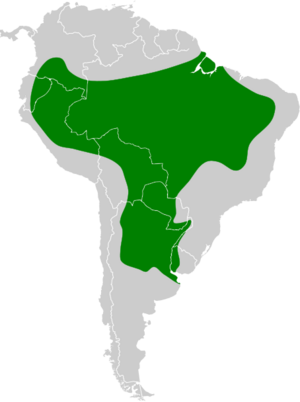Bluish-grey saltator facts for kids
Quick facts for kids Bluish-grey saltator |
|
|---|---|
 |
|
| In the Pantanal, Brazil | |
| Conservation status | |
| Scientific classification | |
| Genus: |
Saltator
|
| Species: |
coerulescens
|
 |
|
| Range in green | |
The bluish-grey saltator (Saltator coerulescens) is a type of passerine bird, which means it's a perching bird. It belongs to the tanager family, called Thraupidae. You can find this bird in many open areas across tropical and subtropical South America.
This bird used to include some groups that are now considered different species. For example, the cinnamon-bellied saltator and the olive-grey saltator were once thought to be the same species as the bluish-grey saltator.
Contents
About the Bluish-Grey Saltator
How it Got its Name
The bluish-grey saltator was first officially described in 1817 by a French bird expert named Louis Pierre Vieillot. He gave it the scientific name Saltator coerulescens. The word coerulescens comes from Latin and means "bluish," which describes the bird's color.
Different Kinds of Saltators
This bird was once known as the greyish saltator. It used to include two main groups of birds. However, in 2021, scientists decided these groups were different enough to be their own species. These are now called the cinnamon-bellied saltator and the olive-grey saltator.
Now, the bluish-grey saltator species includes a few different types, or subspecies. These are known as azarae, mutus, and superciliaris.
What Does it Look Like?
The bluish-grey saltator is about 20 centimeters (8 inches) long. It usually weighs around 52 grams, which is about the same as a small apple.
Its feathers can look a bit different depending on its age and where it lives. But generally, these birds have grey or greenish-grey feathers on their backs and wings. They have a white stripe above their eye, like an eyebrow. Their throat is a narrow white, and their chest is grey. Their belly is a light brown or cinnamon color.
Its Calls and Songs
The bluish-grey saltator has a special call. It sounds like a long, rising sound, like "ch'wheeet" or "ch'kweeee." Sometimes, it starts with a more detailed sound, like "hi'whee chu weeeeh."
Its song is a soft, warbling sound. It's usually quite short and can sound a bit nasal or very smooth and mellow.
Where Does it Live?
This bird lives in many different kinds of open areas. You can find it in woodlands, areas with lots of bushes (scrub), and along the edges of forests. It doesn't usually go deep inside dense forests.
It lives in tropical and subtropical parts of South America. This includes countries like northern Argentina, western Uruguay, Paraguay, and much of Brazil. You can also find it in Bolivia, eastern Peru, eastern Ecuador, and southeastern Colombia. In some northern areas, like near the Guianas and Venezuela, you might find the olive-grey saltator instead.
How Does it Behave?
What it Eats
The bluish-grey saltator eats different kinds of food. It enjoys fruits and buds from plants. It also eats slow-moving arthropods, which are creatures like insects or spiders.
It looks for food at low and middle levels in trees and bushes. Sometimes, you can see them foraging in pairs or small groups. They might even join up with other types of birds in what are called mixed-species flocks to find food together.
Nests and Eggs
The bluish-grey saltator builds a bulky, cup-shaped nest. They usually place their nests about 2 to 4 meters (6.5 to 13 feet) high in a tree.
A female bird usually lays two eggs at a time. These eggs are a pale blue color and are shaped like an oval. They are about 23 to 31.5 millimeters long and 17 to 22 millimeters wide. Each egg weighs about 5 grams. What's interesting about their eggs is that they often have a circle of blackish-brown lines and dots around the wider end.



